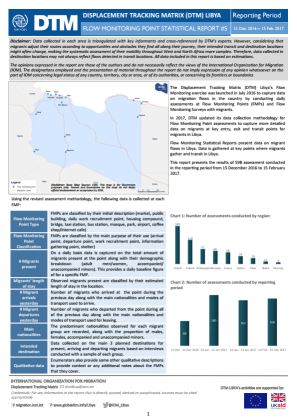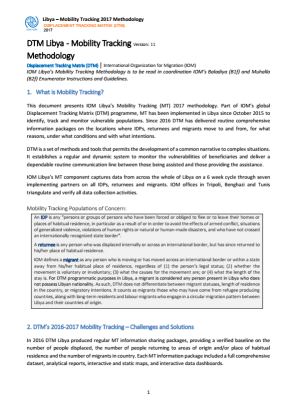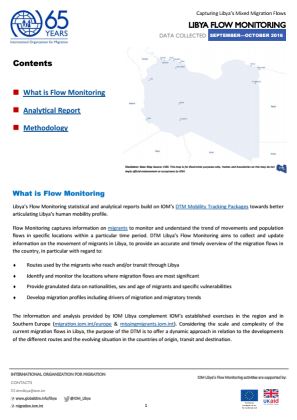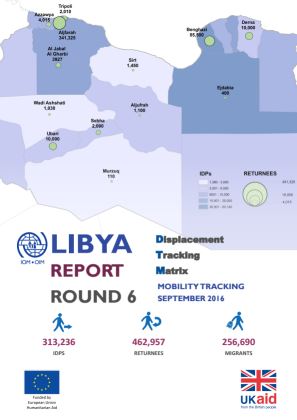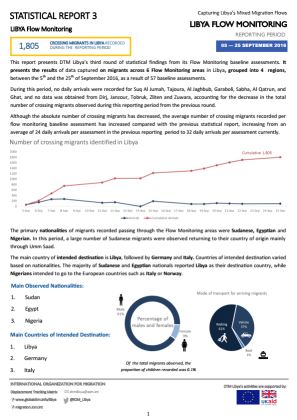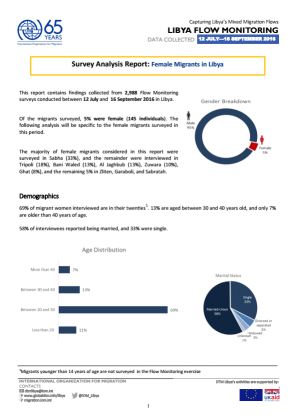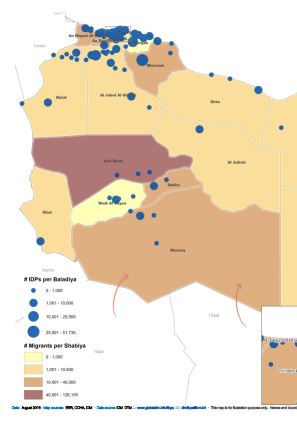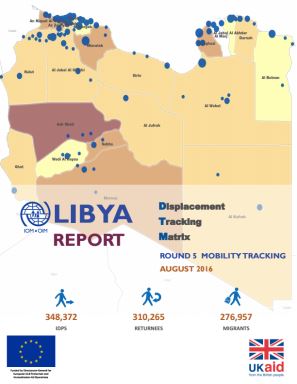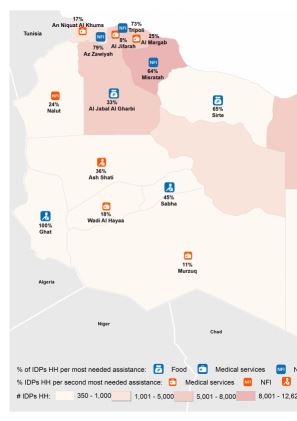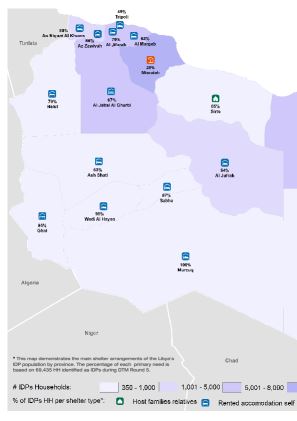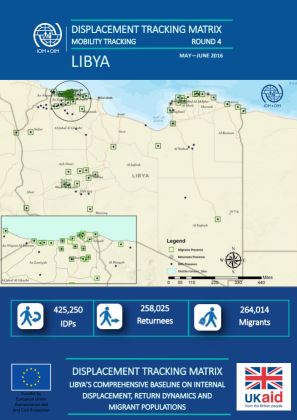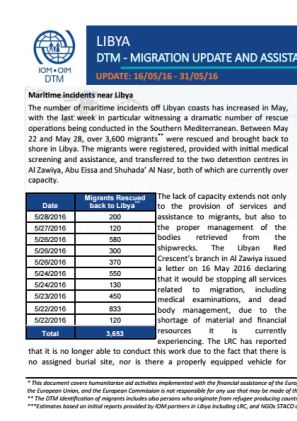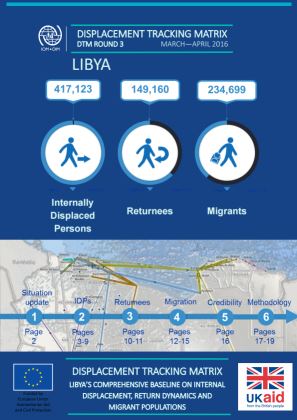-
Countries
-
Data and Analysis
-
Special Focus
-
Crisis Responses
Libya
About Libya
Libya is a geographically vast country with several regions that are difficult to access. In order to understand the full scope of humanitarian assistance that is needed throughout the country, IOM established the Displacement Tracking Matrix (DTM) programme in 2016 in order to provide a common operating picture concerning the movement of populations in Libya, allowing humanitarian actors to provide timely assistance to those in need. Following the escalation of conflict and insecurity in 2014, the security situation has remained volatile since with fluctuations in the intensity of localized clashes. Congruently, conflict has caused new displacements, often in areas ill-equipped to accommodate large population movements while also negatively impacting the large migrant population residing and transiting through Libya. More recently, the capital Tripoli was heavily affected by displacement waves in September 2018 and April 2019.
DTM’s mobility tracking and flow monitoring activities identified many migrants in-country to be in need of various forms of assistance. Libya’s geographic location, resources and work opportunities has made it both a country of destination and transit for migrants for many years. Despite the deterioration of the security situation since 2011 migrants continue coming to and transiting through Libya, the majority from Sub-Saharan and North African countries.
In this complex operating environment, DTM Libya has been providing a common operating picture concerning the movement of populations in Libya since 2016, allowing humanitarian actors to provide timely assistance to those in need. Through its mobility tracking, flow monitoring and needs assessment activities, DTM Libya has established itself as data hub for quantitative data on migratory flows to and within Libya, migrant presence in Libya disaggregated by nationality and area, as well as humanitarian needs of migrants, internally displaced population and returnees. All activities are implemented through periodical bi-monthly data collection cycles, allowing trend analysis over time to provide evidence-base for both policy-level discussions and to guide humanitarian action.
In order to facilitate humanitarian interventions, DTM works closely with IOM’s other programmes through referring identified populations in need of assistance at flow monitoring points to IOM’s Direct Assistance, Health, Voluntary Humanitarian Return (VHR), Protection and Migrant Rapid Response Mechanism (MRRM) programmes. Furthermore, DTM Libya supports other humanitarian partners through providing emergency tracking updates in case of sudden population movements as well as facilitating humanitarian assessments for the Rapid Response Mechanism (RRM) jointly implemented by IOM, UNICEF, WFP and UNFPA.
For more information on IOM's activities in Libya, please visit the IOM Libya country office website.
Contact
DTM Libya
DTMLibya@iom.int
Current Donors
- EUTF
Maritime Incidents Libyan Coast Update (2 – 15 February 2017)
During the period covered 592 people were rescued and 0 bodies were retrieved. A total of 1,400 people have been rescued so far in 2017. A total of 9,448 arrivals by sea to Italy through the Central Mediterranean route have been recorded so far in 2017.
Libya — Flow Monitoring Statistical Report 5 (15 December 2016—15 February 2017)
Flow Monitoring Statistical Reports present data on migrant flows in Libya. Data is gathered at key points where migrants gather and transit in Libya. This report presents the results of 598 assessments conducted in the reporting period from 15 December 2016 to 15 February 2017.
Maritime Incidents Libyan Coast Update (19 January – 1 February 2017)
During the period covered 624 people were rescued and 16 bodies were retrieved. A total of 808 people have been rescued so far in 2017. A total of 4,480 arrivals by sea to Italy were recorded thus far in 2017.
DTM Libya - Mobility Tracking Methodology
This document presents DTM Libya Mobility Tracking methodology, IOM Libya’s Mobility Tracking Methodology is to be read in coordination IOM’s Baladiya (B1F) and Muhalla (B2F) Enumerator Instructions and Guidelines.
Jan 01 2017
DTM Libya - Mobility Tracking Methodology
DTM Libya - Flow Monitoring Methodology
This document presents DTM Libya Flow Monitoring methodology, the Baseline Assessment V.11 forms with notes and guidelines, and IOM’s 5.1 DTM Flow Monitoring Survey form.
Jan 01 2017
DTM Libya - Flow Monitoring Methodology
Libya — 2016 Migration Profiles and Trends
This report presents a cumulative quantitative analysis of baseline data and migrant-focused DTM surveys carried out between the 12th of July and the 15th of December, 2016.
Jan 01 2017
Libya — 2016 Migration Profiles and Trends
Libya — Flow Monitoring Statistical Report 4 (21 November 2016 — 11 December 2016)
This report includes the finding of the data collected trough 43 assessments conducted in Libya between 21 November and 11 December in 6 different FMPs. In this reporting period, 775 migrants were identified across 6 FMPs in 3 areas.
Libya — Flow Monitoring Analytical Report 4 (September — October 2016)
This report presents DTM Libya’s Flow Monitoring survey analysis results obtained from interviews with 1,946 migrants across 9 Flow Monitoring areas in Libya between the 17th of September and the 21st of October 2016.
Libya — IDP and Returnee Report 6 (September 2016)
In Round 6, DTM Mobility Tracking located and identified 313,236 IDP individuals (62,322 households) currently present in 94 areas across the country.
Libya — Flow Monitoring Statistical Report 3 (5—25 September 2016)
This report presents DTM Libya’s third round of statistical findings from its Flow Monitoring baseline assessments.
Libya — Female Migrants in Libya - Statistical Analysis Report (12 July -— 16 September 2016)
This report contains findings collected from 2,988 Flow Monitoring surveys conducted between 12 July and 16 September 2016 in Libya. Of the migrants surveyed, the following analysis will be specific to the 5% female migrants (145 individuals) surveyed in this period.
Libya — Flow Monitoring Analytical Report 6 (August — September 2016)
This report presents the analytical findings from DTM’s Flow Monitoring survey profiles conducted between 14 August and 16 September 2016.
Libya — Flow Monitoring Statistical Report 2 (15 August - 4 September 2016)
Libya’s Flow Monitoring statistical and analytical reports build on DTM’s Mobility Tracking Packages towards better articulating Libya’s human mobility profile. Flow Monitoring is part of IOM’s Displacement Tracking Matrix (DTM).
Libya— Mobility Tracking Report 5 Key Findings Dashboard (August 2016)
This dashboard illustrates the key findings from Libya's Mobility Tracking Report 5 . DTM identified 348,372 IDPs of which 51% were female and 49% were male. DTM also recorded 310,265 returnees: 196,100 from 2015 and 114,095 from 2016.
Libya — IDP and Returnee Report 5 (August 2016)
DTM Libya's Mobility Tracking Report 5 has recorded a reduction in the number of IDPs present in Libya (Benghazi in particular). The number of returnees continues to increase, especially in Benghazi, Derna, Gwalesh and Kikla.
Aug 31 2016
Libya — IDP and Returnee Report 5 (August 2016)
Libya— Mobility Tracking Report 5 Needs Dashboard (August 2016)
This map illustrates the main needs by area. During round 5, data was collected on the most important needs for IDPs in each type of settlement and location.
Libya — Flow Monitoring Statistical Report 1 (12 July — 14 August 2016)
Flow Monitoring Statistical Reports present data on migrant flows in Libya, which is gathered at key points where migrants gather and transit in Libya.
Libya — Mobility Tracking Report 5 Shelter Dashboard (August 2016)
This map illustrates IDP shelter arrangements. 16% of IDP households stay in public or informal shelter arrangements. 84% of IDP households stay in private settings, either self-paid, paid by others, or hosted with relatives or non-relatives.
Libya — IDP and Returnee Report 4 (June 2016)
In Mobility Tracking Report 4, DTM identified 425,250 IDPs, 258,025 returnees and 264,014 migrants (findings on migrants may also include refugees) in Libya.
Jun 30 2016
Libya — IDP and Returnee Report 4 (June 2016)
Libya — Migration and Assistance Overview (1—17 June 2016)
As of 14 June 2016, the Libyan Coast Guard (LCG) had rescued 6,865 irregular migrants and reported 153 fatalities for 2016. Between 1 and 2 June, the LCG in Zuwara retrieved 117 bodies at sea, of which 6 were reportedly children.
Libya — Migration and Assistance Overview (16—31 May 2016)
The number of maritime incidents off Libyan coasts has increased in May 2016, with the last week in particular witnessing a dramatic number of rescue operations being conducted in the Southern Mediterranean.
Libya — Migration and Assistance Overview (3—15 May 2016)
On 15 May 2016, local authorities conducted a rescue at sea operation in Tajourah in Tripoli. 115 migrants were rescued, 50 of whom were women.
Libya — IDP & Returnee Report 3 (March 2016)
DTM assessed all accessible areas of Libya, covering 100 areas out of 104 (Harawa, Sirte, Al Jaghbub and Misratah were all reported as inaccessible). IDPs were identified across 95 areas, returnees were identified in 13 areas and migrants across 29 areas.
Mar 31 2016
Libya — IDP & Returnee Report 3 (March 2016)
Libya — IDP and Returnee Report 2 (February 2016)
This assessment covered 99 areas and 470 locations. DTM identified 331,622 IDPs in 95/99 areas (within 440 locations). DTM interviewed over 800 key informants. In addition, 150,637 returnees have been identified in 19 areas. Displacement from Sirte has continued.
Pagination
Pagination
- First page
- Previous page
- 1
- 2
- 3
- 4
- 5



